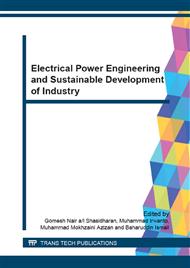[1]
P. Prathap, A. Suryanarayana Reddy, G. Ramachandra Reddy, R.W. Miles, K.T. Ramakrishna Reddy, Solar Energy Materials and Solar Cells, 94 (2010), 1434–1436.
DOI: 10.1016/j.solmat.2010.04.012
Google Scholar
[2]
U. Ozgur, Ya.I. Alivov, C. Liu, A. Teke, M.A. Reshchikov, S. Doğan, V. Avrutin, S. -J. Cho, H. Morkoç Journal of Applied Physics, 98 (2005), 041301-041301-103.
DOI: 10.1063/1.1992666
Google Scholar
[3]
G. Gordillo, C. Calderon, Solar Energy Mater. Solar Cells, 69 (2001), 251–260.
Google Scholar
[4]
R.G. Gordon, Materials Research Society Bulletin, 25 (2000), 52–57.
Google Scholar
[5]
P. Nunes, D. Costa, E. Fortunato, R. Martins, Vacuum, 64 (2000), 293–297.
Google Scholar
[6]
M. de la L. Olvera, H. Gomez, A. Maldonado, Solar Energy Materials and Solar Cells, 91 (2007), 1449–1453.
Google Scholar
[7]
V. Cracium, J. Elders, J.G.E. Gardeniers, Applied Physic Letter, 65 (1994), 2963–2965.
Google Scholar
[8]
F. Quaranta, A. Valentini, F.R. Rizzi, Journal Applied Physic, 74 (1993), 247–248.
Google Scholar
[9]
Y. Natsume, H. Sakata, T. Hirayama, H. Yanagida, Journal Applied Physic, 72 (1992), 4203–4207.
Google Scholar
[10]
A.J.C. Fiddes, K. Durose, A.W. Brinkman, Journal Crystal Growth, 159 (1996), 210–213.
Google Scholar
[11]
K. Jong Lee, B. Ho Jun, T. Hoon Kim, J. Joung, Nanotechnology, 17 (2006), 2424–2428.
Google Scholar
[12]
Jae K. Lee, Ue J. Lee, Myung-Ki Kim, Sang H. Lee, Kyung-Tae Kang, Thin Solid Films, 519(2011), 5649-5653.
Google Scholar
[13]
Kyoung-Hwan Shin, Joonhyuk Cho, Jyongsik Jang, Hyun S. Jang, Eung S. Park, Kigook Song, Sung H. Kim, Organic Electronics, 13(2012), 715-720.
Google Scholar
[14]
M. Morozova, P. Kluson, J. Krysa, P. Dzik, M. Vesely, O. Solcova, Sensors and Actuators B: Chemical, 160(2011), 371-378.
DOI: 10.1016/j.snb.2011.07.063
Google Scholar
[15]
Zhiyun Zhang, Chonggao Bao, Wenjing Yao, Shengqiang Ma, Lili Zhang, Shuzeng Hou, Superlattices and Microstructures, 49(2011), 644-653.
Google Scholar
[16]
Y. Y. Chen, J. C. Hsu, P. W. Wang, Y. W. Pai, C. Y. Wu, Y. H. Lin, Applied Surface Science, 257(2011), 3446-3450.
Google Scholar
[17]
Christian Weigand, Ryan Crisp, Cecile Ladam, Tom Furtak, Reuben Collins, Jostein Grepstad, Helge Weman, Thin Solid Films, 545(2013), 124-129.
DOI: 10.1016/j.tsf.2013.07.052
Google Scholar
[18]
B. G. Choi, I. H. Kim, D. H. Kim, K. S. Lee, T. S. Lee, B. Cheong, Y. J. Baik, W. M. Kim, Journal of the European Ceramic Society, 25(2005), 2161-2165.
DOI: 10.1016/j.jeurceramsoc.2005.03.023
Google Scholar
[19]
K. F. Cai, E. Müller, C. Drašar, A. Mrotzek, Materials Science and Engineering: B, 104 (2003), 45-48.
Google Scholar
[20]
H. Cheng, X. J. Xu, H. H. Hng, J. Ma Ceramics International, 35(2009), 3067-3072.
Google Scholar


